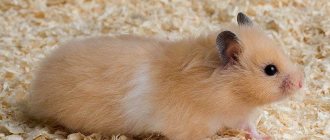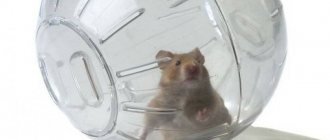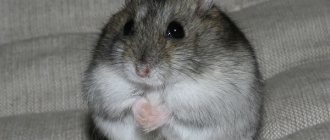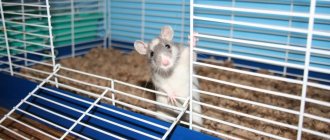Hamsters may still be considered the "standard" pet rodent, but rats have gained many fans over the years. Many rat owners claim that their chosen pet has a lot of advantages - if you don't pay attention to the tail. They're smart, clean and playful, but when it comes to rats versus hamsters, who really wins the battle?
Appearance of rodents
There is no denying the fact that hamsters are beautiful to look at. Their rounded bodies and miniature faces, combined with a fur coat, create a very attractive appearance.
To their fans, the rats are just as beautiful and come in almost as many colors as the traditional Syrian hamster. The two most common external characteristics of rats that intimidate their potential owners are their hairless tail and large body proportions. But it is important to remember that the rat's tail has a very important purpose.
The rat's tail is incredibly effective for balance, which in turn makes pet rats much more acrobatic than hamsters. They happily jump and climb around the cage, where the hamster constantly trips.
Outside their cage they are just as well balanced and will happily climb around your room, and they can also crawl on your body without any problem. This actually makes rats easier to handle than hamsters as they are much less likely to get into trouble.
Gray or common mouse
Gray mouse.
Body length – 8.5 – 12.3 cm, tail length – 2.8 – 4.5 cm. Weight – 14 g. Color gray. Sometimes with a brown or reddish tint. Settles in meadows and treeless areas. The burrows are from 10 to 70 cm deep. This is influenced by the time of year and the topography.
The diet consists of 88% green parts of plants, the rest comes from seeds and wild plants. In summer and spring, they consume asteraceae and cereals, and in winter, tree bark.
Feed intake is 70% of body weight per day. In the cellars they eat grain, root vegetables, cabbage, and potatoes. They carry leptospirosis, toxoplasmosis, pig erysipelas, and tularemia. Life expectancy is 8 to 9 months.
Sizes of rat and hamster
In terms of size, rats are certainly larger than hamsters, although their long tails can make them appear much larger than they actually are. They are also more active, which requires a significantly larger cage if you want to keep them happy.
The upside to rats' size is that they are easier to handle and harder to slip through tiny cracks in the cage. Whereas hamsters, due to their small size, can easily get lost in a room after escaping from their cage.
How to distinguish a hamster from a decorative mouse
Many people wonder how to distinguish a representative of the hamster family from mice. It's pretty simple. It is enough to pay attention to such characteristics as:
- size – hamsters are usually larger than decorative mice;
- the presence of a cheek pouch in hamster breeds, its absence in mouse breeds;
- the presence of a thin, long tail in mice;
- fur color - in hamsters it can be multi-colored, black, white, gray, but in mice it can only be white or gray.
Comparing which pet is more active is pointless for the reason that everything depends on their habitat. Basically, both of these animals love various accessories designed to train strength and endurance, so they must be present in the cage.
Pet personalities
If there's one personality trait that most hamster owners can agree on, it's that hamsters can be quite grumpy at times. They are naturally nocturnal and begin to wake up in the evening. If you wake them up early, they will be very unhappy.
Of all the common domestic rodents, hamsters are the ones that bite most often. This is especially true for small species of hamsters - for example, Russian and Chinese. Remember also that hamsters are not only annoying to their owners from time to time - they can be even more rude to members of their own species. For this reason, there is no need to anger the old hamsters, otherwise serious fighting may begin.
Rats in general have a calmer attitude towards both people and other animals. Although their teeth may be larger than those of hamsters, they use them much less frequently. If you don't stick your fingers through the grate where your pet can bite them, thinking it's food, then you're much less likely to be bitten by a rat than by a hamster. For young children this can be a very positive thing.
Steppe pied
Until recently, this species was considered a dangerous pest. However, due to the small number of remaining individuals, they were included in the Red Book . Habitat: steppes, semi-deserts, forest-steppes. It can live in river valleys and lake basins, as well as on the slopes of ravines.
Activity is around the clock. Burrows at a depth of 30–90 cm. In winter, they can build a tunnel under the snow. The body is 8–12 cm long, the tail length is 7–9 mm. Life expectancy reaches 20 months, although in captivity some live up to 2 years.
The color is monochromatic. They feed on tubers, bulbs, seeds, bark of shrubs, and green parts of narrow-leaved cereals.
They themselves are prey for the fox and corsac. A fox can eat 100 animals within a month.
Steppe moth.
Comparison of intelligence
There is a very good reason why rats have a high survival rate in the wild - their superior intelligence. Rats are among the most intelligent creatures of their size, capable of quickly solving seemingly complex problems.
For pets, this intelligence can be a good thing. Many pet rats are capable of learning tricks and can also recognize different family members. This can make them very attractive as pets.
The downside to this intelligence is that great care must be taken to ensure proper brain activity for them at all times. Not only should rats get out of their cage regularly to interact with people, but it is also important that they have adequate space and a range of toys to entertain themselves with.
Also note that it is recommended to keep two or more rats together so that they always have company.
Although toys are available for hamsters, they tend to be less interested in them. Sometimes a hamster can use a simple wheel, no matter how much money you have invested in expensive toys.
Bird keeping
If you do not want to have rodents, opt for ornamental birds. They are also found in cells. They live long, are easy to train, and attractive in appearance.
There are also disadvantages:
- Parrots are noisy, they can chirp from the very morning, you have to cover the cage.
- They are in poor health.
- The bird must be released from the cage to fly.
The choice of pets is now very large. But do not forget that exotic species of animals require special care and costs. A hamster is the easiest to keep, which explains its popularity among children and adults.
Advantages and disadvantages of rats
There are many reasons why rats make great pets, here are a few:
- More social
: Rats are incredibly social creatures that need a lot of attention. It is recommended to keep them in pairs and they will often play with their cage mates. They are also very friendly with their owners, enjoying cuddles and shoulder walks. - High Intelligence:
Rats are the most intelligent rodents and are commonly used in psychological research. For pet owners, this means that they are easy to train (potty train and teach tricks) and easily form bonds with their owners. - Stay awake longer during the day
: Rats, like most rodents, are technically nocturnal, however pet rats tend to adapt easily to their owners' wake/sleep patterns compared to hamsters, which are not as adaptable. - Less likely to bite:
Contrary to popular belief, rats are very gentle creatures and tend to bite only when they are very scared. Accidental bites are common in all rodents, but bleeding bites are incredibly rare when it comes to rats. - Easy to Handle
: They are larger and weigh on average 4 times more than hamsters, making them much easier to look after.
Rats also have disadvantages, for example:
- Prone to Certain Health Problems
: One of the disadvantages of rats is that they are susceptible to various health problems such as respiratory infections and tumors. This means they may need more trips to the vet. - More Expensive
: Rats need more specialized equipment, such as larger cages, bedding, and quality food, not to mention plenty of toys to keep them from getting bored. - They must be kept in pairs
: rats are very sociable and do not live long on their own. Keeping at least two rats (of the same sex) is highly recommended as they will become lonely if left alone.
Wood mouse
Body length ranges from 8 – 11.5 cm, tail length from 3 to 6 cm. Weight – 17 – 35 g. The color of the back is rusty-brown with a grayish-whitish belly. The tail is two-color.
Their habitat is forest and forest-steppe. They prefer to settle in deciduous and coniferous forests. Even swampy areas of forest-tundra are not alien to them. They are also able to climb mountains.
Activity is around the clock at any time of the year. The burrows are made shallow and short. They can hide in crevices of tree roots. They easily climb trees and bushes.
They feed on herbaceous plants, seeds, bark, shoots, moss, lichen, and invertebrates. In gardens and forests they cause harm and also transmit tick-borne typhus fever and leptospirosis. Mice are the main source of food for mustelids.
Forest mice.
Pros and cons of hamsters
Hamsters have the following advantages:
- They are easy to care for:
Hamsters are relatively easy to keep. They do not need as frequent cleaning as rats and do not require attention. - Cheap to keep
: Hamsters have a lower initial cost than rats because they are smaller and don't need as large cages. Their food is also more accessible and cheaper. - You can only keep one hamster:
the hamster is a solitary creature that prefers its own company. - Doesn't require much space
: Hamsters can live happily in much smaller cages than a rat would require.
Cons of hamsters:
- Less Intelligent
: Hamsters are not as intelligent as rats and, as a result, are less affectionate and interactive pets. They are also more difficult to train. - Sleep a lot:
Like rats, hamsters sleep during the day. However, hamsters are more difficult to train to their owners' schedules and may become grumpy and bite when they wake up. - Noisy at night
: Due to the fact that hamsters are nocturnal, they can be very noisy at night, running around on wheels, etc. - Not as Affectionate
: While all pets form bonds with their owners over time, hamsters lack the intelligence equivalent to rats and are therefore less affectionate and loving.
Who better to have at home
To choose the right pet, it is recommended to consider not only the pros and cons of animals. You also need to think about what is best for the owner. If you need a smart, affectionate and sociable friend, get a rat. For those who like to watch the funny fuss of furry babies, a hamster is suitable.
In any case, soon the small animals will become part of the family, and their shortcomings will fade into the background.
All of the above pros and cons are conditional and are, rather, part of a subjective assessment. In fact, it is impossible to say exactly which animal is better. You can only determine who is more suitable by character.
Hamsters may still be considered the "standard" pet rodent, but rats have gained many fans over the years. Many rat owners claim that their chosen pet has a lot of advantages - if you don't pay attention to the tail. They're smart, clean and playful, but when it comes to rats versus hamsters, who really wins the battle?











